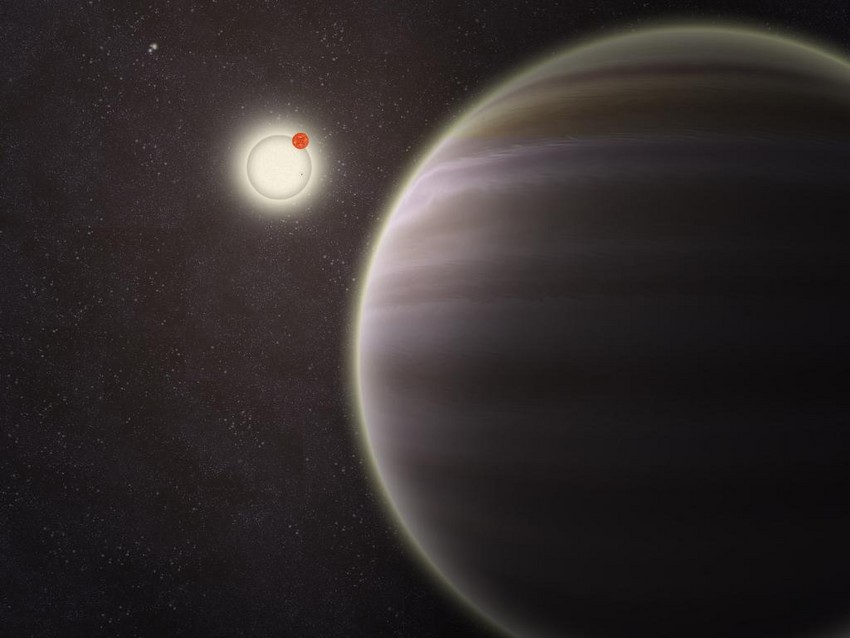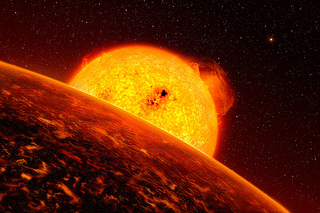Two new planets came to light this week, and one of them was crowd-sourced
By Lewis Wallace

Two new planets came to light this week, and one of them was crowd-sourced
By Lewis Wallace
A project that crowd-sources astronomical research announced its first discovery Tuesday: a new planet called PH1, short for Planet Hunters.
Planet Hunters is a website co-sponsored by Chicago’s Adler Planetarium that allows everyday people to analyze data about stars.
The citizen scientists’ discovery is not to be confused with another new planet announced this week: European researchers discovered the closest known planet to Earth in the Alpha Centauri solar system. But both discoveries are being hailed as valid and significant.
“These (Planet Hunters) are real discoveries made by just regular members of the public, armchair astronomers if you like,” said Arfon Smith, Director of Citizen Science at the Adler Planetarium.
The Planet Hunters site allows anyone to view data compiled from NASA’s Kepler Spacecraft. But NASA is not a sponsor of the project; Planet Hunters is an independent collaboration using data the Kepler research team has made available to the public.
The Planet Hunters website was launched as an experiment, in part with the goal of finding out whether the human eye could sometimes be more efficient than a computer at analyzing data. Citizen planet seekers look for inconsistencies in light patterns created by distant stars. These inconsistencies, analyzed by the human eye in large numbers, can demonstrate that a previously unknown planet is passing between the Kepler telescope and the star in question.
The website keeps a list of “candidates” for planets, and among the candidates PH1 is the first winner. Two citizen scientists, Kian Jek and Robert Gagliano, headed up the effort to confirm the existence of PH1. After their research was reviewed by the team of scientists behind Planet Hunters, the whole group submitted a paper to the Astrophysical Journal and made it available online October 15.
PH1: The Double Star Wars Planet
PH1 is about 5,000 light years away from earth. It is notable because it is the first planet discovered in a four-sun solar system.
The planet itself orbits two stars, which doesn’t distinguish it much from a series of binary star solar systems discovered by NASA in the last couple years. In these systems—sometimes called “Tatooine” systems after the two-star solar system featured in Star Wars—planets make one orbit around two suns, which also orbit each other. PH1 takes the Tatooine formation and doubles it; in the PH1 system there is a second pair of stars just an astronomical stone’s-throw from PH1’s pair.
Astronomers have never seen anything quite like it, and the discovery has implications for research into how planets are formed.
“The model that scientists use to predict how planets form…would predict that this planet could not exist, and yet it does,” said Smith. “It’s posing lots of new questions for the whole planet-formation science community.”
Fred Ciesla, assistant professor of geophysics at the University of Chicago, agreed. Ciesla researches planet formation, and he said scientists are still trying to figure out models that account for the formation of planets in a two-star system. Finding a planet in a four-star system, he said, “is an exciting discovery, and it means that we can’t limit ourselves to just considering systems like our own sun.”
Meanwhile, in Alpha Centauri…
This week scientists announced another key planet discovery: the closest planetary neighbor we may ever find outside our own solar system. A group of researchers at the University of Geneva in Switzerland used data from a telescope in Chile to demonstrate the existence of a rocky planet the size of Earth in the solar system Alpha Centauri, just 4.4 light years away.
A few light years makes Alpha Centauri our next-door neighbor in astronomical terms, and the closest known exoplanet, or planet outside our own solar system. Still, it would take our speediest spacecraft tens of thousands of years to travel to the three-star system.
Alpha Centauri is a solar system with three suns that can be seen with the naked eye from night skies south of Tampa. The new planet orbits one of the suns, known as Alpha Centauri B, and it was detected by observing the effect of the planet’s gravitational field on its surroundings over several years.
“This is making us very happy,” said Dan Joyce, the president of the Chicago Astronomical Society. He reminded us that the Alpha Centauri system was the implied setting of the sci-fi film Avatar. “Maybe what they were doing with the movie Avatar was not all that wacky after all.”

Of course, the new planet would not make a good environment for humans, avatars, or any other life form. It orbits very close to its sun, and the surface temperature is around 1,200 degrees Celsius. But scientists often find that where there is one planet, there are more. In theory, another planet could be found in what is called the habitable zone, or the appropriate distance from a star to have a livable surface temperature.
Extraterrestrial Implications
Afron Smith said the pace of planet discovery has increased dramatically in recent years—and the discoveries have big implications for the search for life outside our solar system.
“When I was ten, we didn’t know of any planets going around any other stars apart from our own sun,” he said. The first exoplanet was discovered in 1995.
Now, Smith said it’s probable that a majority of stars in the universe have planetary systems. That’s significant because the more planets researchers come across, the more likely it is that a planet somewhere out there resembles earth.
The discovery of exoplanets, Smith said, “introduces questions about how many other civilizations there are in the universe. Are we particularly special as humans?”
Was he talking about extraterrestrial life?
Yes, he was.
Planet-seeking is not only a crowd-sourced activity now. It’s a key piece of the search for life beyond earth.
“If you’re interested in trying to work out how likely life is in the universe outside of our own solar system,” Smith said, “then this is a crucial factor.”
To help search for new planets, go to www.planethunters.org.
